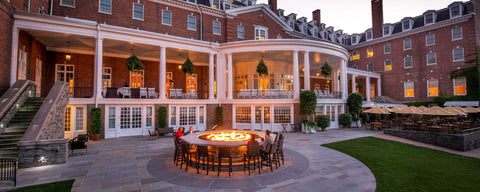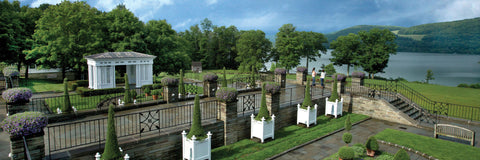“New York is divided into more discrete regions than any other state I know of … Cooperstown doesn’t really fall under any of these regional categories. It’s its own stop.”
–Henry Cooper
It’s a sunny summer’s day at the Fenimore Art Museum in Cooperstown. On the short walk from the Museum’s back door to a gazebo overlooking Otsego Lake, Henry Cooper is greeted by every person he passes. After all, this is quite literally Henry Cooper’s town. His story of this place, founded by his ancestors, is about so much more than its predominant reputation as the capital of baseball. Instead, it is one of a wild and beautiful frontier that he’s on a mission to preserve.*
Mr. Cooper’s family has always had roots in Cooperstown. His three times great-grandfather William Cooper, father of author James Fenimore Cooper, founded the village. “[William Cooper] basically built a farming community with the village of Cooperstown [at] its center,” explains our Mr. Cooper. “[James Fenimore Cooper] lived here after his father did. And really every generation since then we’ve continued to come back.” Throughout his multi-faceted career and involvement between Cooperstown and New York City, Mr. Cooper has always been interested in greater explorations and odysseys. Mr. Cooper became very interested in the work of Jules Verne, which later led to his notable coverage of NASA’s space missions at “The New Yorker.” “I got to the New Yorker in about 1958, which was after Sputnik … and science suddenly became the zippiest thing around,” Mr. Cooper says. “Many people who are my age arrived at The New Yorker and in that period, many of whom had any scientific background, even the English majors would just gravitate to one science or the other … it was a very exciting time.” Cooperstown’s success and growth after its founding truly begins with Edward Severin Clark, grandson of Edward Clark, a co-founder of the Singer Corporation Sewing Machine Company (and also a co-investor in, and builder of, Manhattan’s Dakota residential building). Edward Severin Clark and family bought 10,000 square miles of land around Otsego Lake, granting them enormous influence over the town. “The Clarks had about half the village on their payroll,” says Mr. Cooper. “They thought it was time to start various enterprises that would make the village more self-sufficient.” With a tourist economy in mind, Clark built many of Cooperstown’s prominent buildings and museums, including the still extant Otesaga Resort Hotel.

Another of those Clark-funded local enterprises was the Baseball Hall of Fame. Local legend tells the story of how baseball was invented by a Cooperstown native and Civil War General by the name of Abner Doubleday. “They started the Hall of Fame, and they called Cooperstown ‘the birthplace of baseball,’” explains Mr. Cooper. “And as the years went on, it became clearer that baseball was never really invented in any one place … Cooperstown morphed from being the birthplace of baseball to being the home of baseball — what it calls itself now.” The village quickly evolved into baseball mecca after the 1970s, when the sport was elevated from national pastime to a sport of religious devotion. The Clarks built two other historic institutions: Fenimore House (now the Fenimore Art Museum, and site of our interview) and the Farmers’ Museum located just across the street. The museum features living history displays of 1840s trades and farming traditions.

Fenimore Art Museum. Photo: Fenimore Art Museum Website
For the richness of its history and its cultural options, Cooperstown is a vibrant town in which to live. Mr. Cooper has had the distinct privilege of claiming two places in the State as his hometowns. Growing up, he spent the school year in Manhattan’s Upper East Side and migrated to Cooperstown for the summer; though long out of school he maintains that schedule to this day. “It’s nice when you live in two very different places,” says Mr. Cooper, “And I find that each one enhances the other; it would be impossible to live all year-round in Cooperstown without New York [City], and it would be impossible to live in New York [City] year-round without being able to get away to Cooperstown.” His complementary lives between New York State’s “deep city” and “deep country” have inspired a lifelong love of New York City, as well as a commitment to the preservation of Cooperstown’s natural origins. Now in his 80s, Mr. Cooper is involved in various institutions and organizations around Cooperstown that, in his view, “kind of make the place tick.” These include Hyde Hall, a former residence and now a National Historic Landmark, and Otsego 2000, a group founded by those involved with the area’s environmental movement. “What’s been true is that over the last 25 years the beauty of this place, more or less natural 19th century landscape, has been under one challenge after another from various outside sources,” explains Mr. Cooper. Founded in 1981, Otsego 2000 initially came together when the State planned to run a huge power line behind the head of Otsego Lake, threatening to destroy the aquatic life and the organic beauty of the area, “and we’ve fought many battles since then,” says Mr. Cooper. Otsego 2000 has addressed other controversies related to preserving the natural integrity of Cooperstown and Otsego Lake — famously dubbed “Glimmerglass” by James Fenimore Cooper in his “Leatherstocking tales” — such as a proposed public boat launch on Hyde Bay, which posed a threat to the lake’s wildlife, and the reduction in the number of visually disruptive wind turbines being constructed within view of the lake. Otsego 2000 is not against alternative energy resources, but the group is opposed to any proposal that becomes an environmental threat to the climate of Central New York. Currently, the group is proposing alternatives to the widely-controversial approach to tapping natural gas: hydraulic fracturing, better known as “hydrofracking.” “In the course of [fracking], [the process is] very apt to pollute your local water supply, your underground aquifers for one,” Mr. Cooper warns. And that pollution would also carry over into streams, lakes and reservoirs on the surface of the drilling location. High costs and cautionary tales from Pennsylvanians, who have seen the downfalls of drilling firsthand over the last six to eight years, contribute to Otsego 2000’s argument to reconsider the development of a fracking infrastructure in Central New York. “The fact is, the extraction process leaves a huge carbon footprint — they’re saying within the same realm of coal and oil,” Mr. Cooper states. “We’re not opposed to natural gas, but we’re opposed to pollution, particularly in the natural water supply.” Mr. Cooper explains that his ancestor James Fenimore Cooper would want to conserve the natural ecosystems in the area because: “[Nature] sustains you.” Mr. Cooper admits to invoking the poetic magic of his ancestor’s prose during Otsego 2000’s appeals to local planning boards and state government. Consider this excerpt from “The Deerslayer”:It would be difficult to convey to the minds of those who have never witnessed it, the sublimity that characterizes the silence of a solitude as deep as that which now reigned over the Glimmerglass. In the present instance, this sublimity was increased by the gloom of night, which threw its shadowy and fantastic forms around the lake, the forest, and the hills. It is not easy, indeed, to conceive of any place more favorable to heighten these natural impressions, than that Deerslayer now occupied. The size of the lake brought all within the reach of human senses, while it displayed so much of the imposing scene at a single view, giving up, as it might be, at a glance, a sufficiency to produce the deepest impressions.
Mr. Cooper’s persuasive presentations are often victorious; so far, so good. Mr. Cooper describes the State of New York as a “great anomaly, because it includes this small area, known as New York City, which is entirely different from a far larger area, which is the rest of the State. And the two rarely coincide or get together.” He has proved otherwise through his devotion to both towns. And he is a bit of an anomaly himself (he even makes an appearance in Wes Anderson’s film “The Life Aquatic”), but teaches us that a strong sense of history can often defend our surroundings and preserve what is important.*
CORRECTION: This article reported that Otsego 2000 was founded in 1981 in part to combat a State initiative to run a power line under Otsego Lake; instead, the power line was proposed to run behind the head of the lake.
Leave a comment